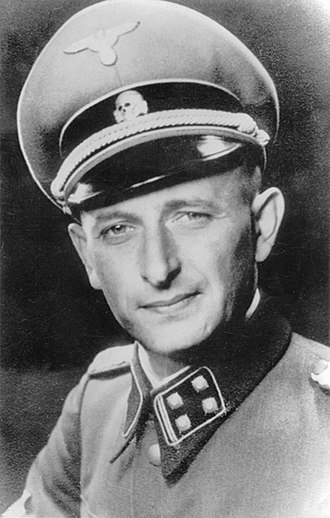Adolf Eichmann

Otto Adolf Eichmann (19 March 1906 in Solingen – 31 May 1962 in Ramla) was an important SS officer in Nazi Germany.
Eichmann played a key role in planning the Holocaust[1] (which killed 6 million Jews and millions of others between 1941-1945[2][3][4]).
He was executed for war crimes and crimes against humanity in Ramla, Israel on 1 June 1962, at the age of 56.[1]
Early life
On 19 March 1906 Eichmann was born in Solingen, Prussia, in the German Empire. Seven years later, his family moved to Linz in Austria-Hungary.
On 1 April 1932, he joined both the Austrian Nazi Party and the Austrian Branch of the National Socialist German Worker's Party (NSDAP).[5]
Two years later, he also joined the Schutzstaffel (SS), a Nazi paramilitary organization led by Heinrich Himmler and deputy head Reinhard Heydrich.
Career in the SS
Eichmann reached the rank of SS-Obersturmbannführer (which was equal to the rank of lieutenant colonel in the German Army). He led the Jewish Department of the Reich Main Security Office (Reichssicherheitshauptamt, Referat IV B4).

Senior Nazi officials, including Reinhard Heydrich, gave Eichmann the power to plan the logistics of the "Final Solution to the Jewish question."[1][5] Berenbaum (2024) writes:
"[A]lthough it was not yet generally known that the “final solution” was mass execution, Eichmann had in effect been named chief executioner. Thereupon he organized the identification, assembly [gathering together], and transportation of Jews from all over occupied Europe to their final destinations at Auschwitz and other extermination camps in German-occupied Poland."[1]
Escape and capture
Eichmann escaped Germany after World War II ended. In 1960 the Mossad (the Israeli secret service) located him living with his wife in Argentina.[5] Mossad agents kidnapped Eichmann and took him back to Israel so he could be put on trial for war crimes and crimes against humanity.[1]
An Israeli court found Eichmann guilty on December 11, 1961. One of the few people ever to be executed by Israel, he was hanged in Ramla the following May. His body was cremated in an unusually hot furnace, and the ashes were scattered in the sea.[6]
Impact
Eichmann's trial was broadcast on radio in Israel, and millions of people around the world watched it on television. This was the first time that victims of the Holocaust talked openly about what had happened. As a result, people became much more aware of the Holocaust and its effects. Research, publications, and discussions about the Holocaust increased.[7] In the newly formed nation of Israel, the trial helped bring together and unify people.[6]
According to Neil Bascomb:
The purpose of catching Eichmann was clear from the beginning — one, to remind the world what the Germans did to the Jews, and two, to remind Israeli youth why the state of Israel needs to exist. [...] The whole purpose and execution of the trial was to that end, and it was quite successful.”[7]
| SS Rank | Equivalent German Army Officer Rank | Date and Year |
|---|---|---|
| Untersturmfuhrer/Obersturmfuhrer | Lieutenant | 1935-1937 |
| Hauptsturmfuhrer | Captain | 1937 |
| Sturmbannfuhrer | Major | 1937-1938 |
| Obersturmbannfuhrer | Lieutenant-Colonel | 1938-1945 |
Adolf Eichmann Media
Adolf Eichmann's Lebenslauf (résumé) attached to his application for promotion from SS-Hauptscharführer to SS-Untersturmführer in 1937
Map showing the location of the General Government, 1941–1945
Memorial to Holocaust victims at a bus stop near the site of Eichmann's office, Referat IV B4 (Office of Jewish Affairs) at Kurfürstenstraße 115/116, Berlin, now occupied by a hotel
Hungarian woman and children arrive at Auschwitz-Birkenau, May or June 1944 (photo from the Auschwitz Album).
Red Cross passport for "Ricardo Klement", used by Eichmann to enter Argentina in 1950
The teleprinter that was used to send messages regarding the capture of Eichmann to Israel's diplomatic missions around the world
Eichmann in the yard of Ayalon Prison in Israel, 1961
References
| Wikimedia Commons has media related to Lua error in Module:Commons_link at line 62: attempt to index field 'wikibase' (a nil value).. |
- ↑ 1.0 1.1 1.2 1.3 1.4 Berenbaum, Michael (2024-09-09). "Adolf Eichmann: Role in the Holocaust, Trial, & Death". Encyclopedia Brittanica. Retrieved 2024-09-24.
- ↑ United States Holocaust Memorial Museum. "How Many People did the Nazis Murder?". encyclopedia.ushmm.org. Retrieved 2024-09-24.
- ↑ "Holocaust Misconceptions". Illinois Holocaust Museum. Retrieved 2024-09-24.
- ↑ Friedrichs, Jonathan. "Will the Exact Number of Jewish Victims Ever Be Known?". Vancouver Holocaust Education Centre. Retrieved 2024-09-24.
- ↑ 5.0 5.1 5.2 "Adolf Eichmann (1906 -1962) | American Experience | PBS". www.pbs.org. Retrieved 2024-09-24.
- ↑ 6.0 6.1 Esler, Gavin (2011). "How Nazi Adolf Eichmann's Holocaust trial unified Israel". British Broadcasting Corporation (BBC).
- ↑ 7.0 7.1 Rothman, Lily (2018-08-29). "The True Events of 'Operation Finale' Were Only One Part of the Eichmann Story". TIME. Retrieved 2024-09-24.








